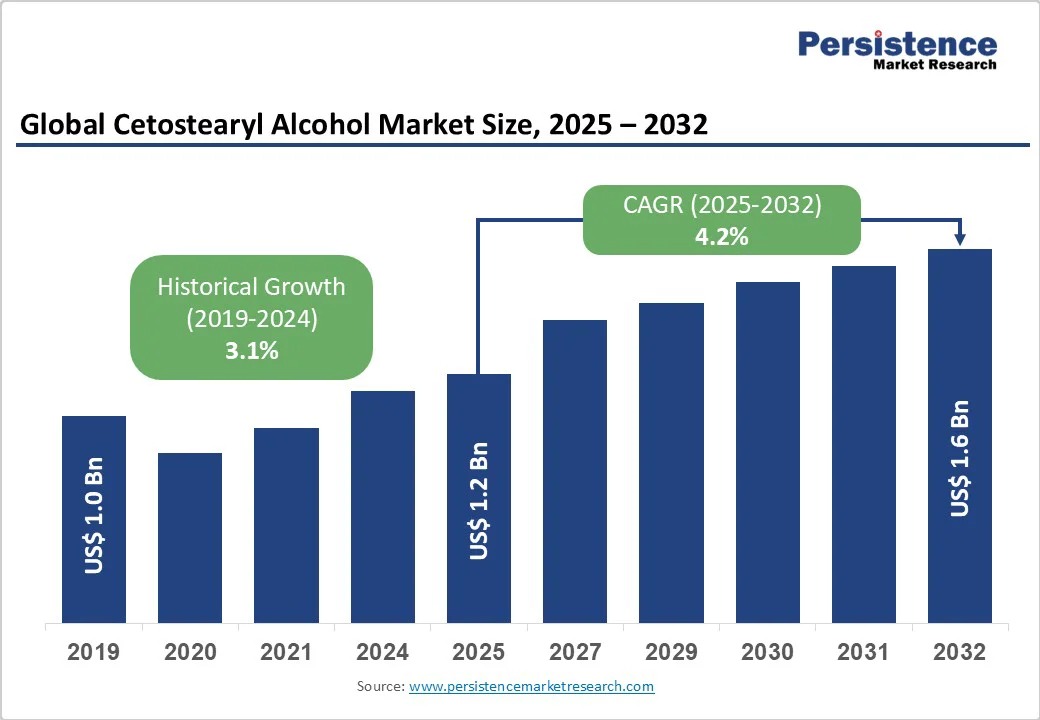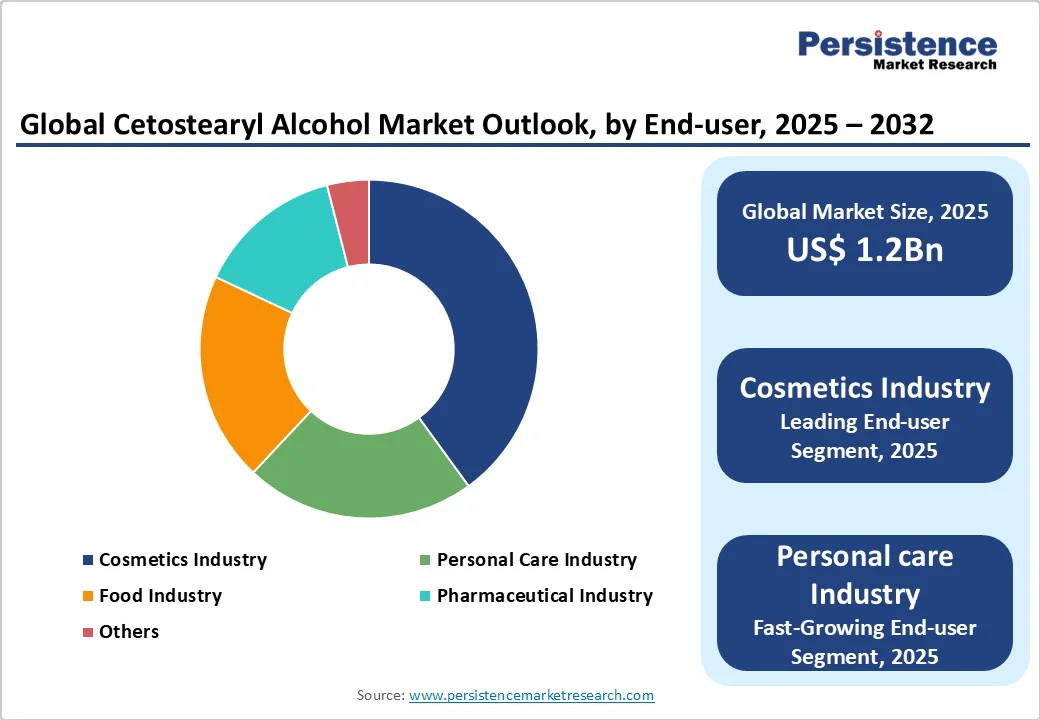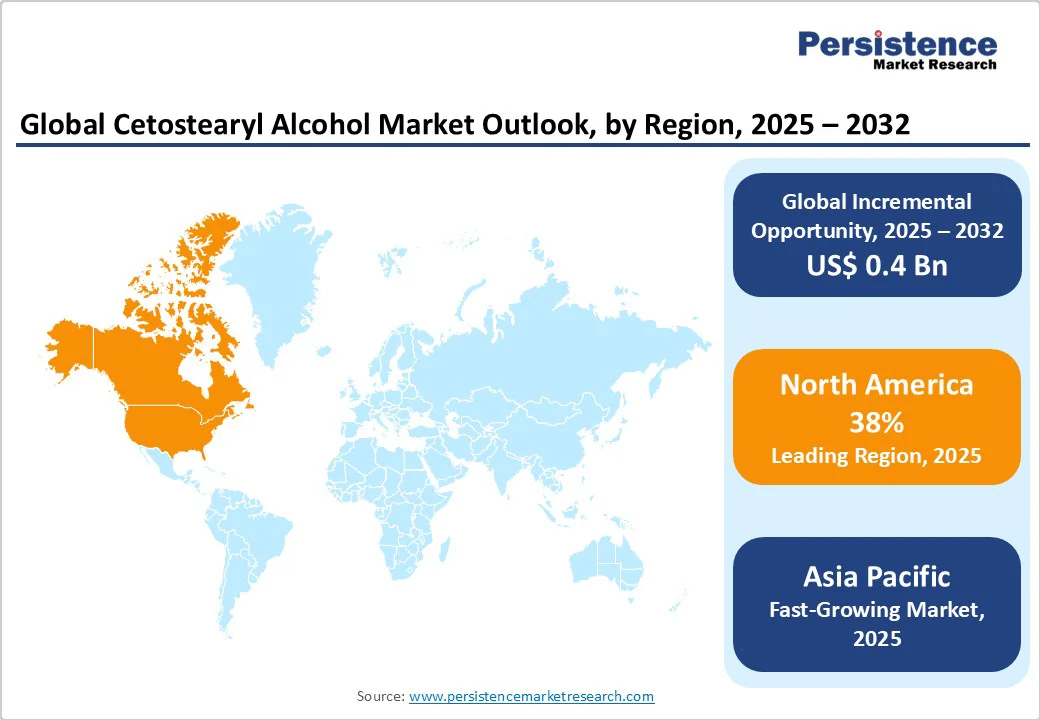ID: PMRREP26098| 198 Pages | 1 Oct 2025 | Format: PDF, Excel, PPT* | Chemicals and Materials

The global cetostearyl alcohol market size is likely to be valued at US$1.2 Bn in 2025 and expected to reach US$1.6 Bn by 2032, registering a CAGR of 4.2% during the forecast period from 2025 to 2032.
The cetostearyl alcohol market has experienced robust growth, driven by the rising demand for natural emulsifiers, advancements in production technologies, and the increasing need for sustainable health and wellness solutions.
| Key Insights | Details |
|---|---|
| Cetostearyl Alcohol Market Size (2025E) | US$1.2 Bn |
| Market Value Forecast (2032F) | US$1.6 Bn |
| Projected Growth (CAGR 2025 to 2032) | 4.2% |
| Historical Market Growth (CAGR 2019 to 2024) | 3.1% |

The global surge in health and wellness demands is a primary driver of the cetostearyl alcohol market. The cosmetics and personal care sector is experiencing steady growth, with natural ingredients such as emulsifiers playing a critical role in addressing lifestyle diseases and consumer preferences for clean beauty.
This rising demand, particularly in regions with high awareness of skin health and nutrient depletion in daily routines, underscores the need for effective cetostearyl alcohol, which provides stabilizing and moisturizing properties for skin barrier enhancement, hydration benefits, and formulation stability. The cosmetics market continues to expand, highlighting the shift toward multifunctional ingredients that support both efficacy and sustainability.
The cosmetics industry is increasingly adopting natural ingredients, where cetostearyl alcohol excels in emulsion stability and texture enhancement, driving formulation innovations across lotions, creams, and serums. Consumers are showing a clear preference for natural over synthetic emulsifiers in personal care products, with strong emphasis on sustainable sourcing to meet millennial and Gen Z demands.
Pharmaceutical applications also benefit from cetostearyl alcohol’s biocompatibility, with growing recognition of its role in topical formulations for managing skin conditions such as eczema and psoriasis, leading to steady growth in pharma integrations. The pharmaceutical excipients market is expanding, further bolstering demand for versatile agents such as cetostearyl alcohol in ointments and creams.
Technological advancements in oleochemical processing, such as enzymatic hydrogenation, have improved production efficiency, making it more accessible for mass market applications and further fueling growth. Additionally, the food industry’s push for natural thickeners aligns with cetostearyl alcohol’s use in emulsions for processed foods, where it enhances shelf life without synthetic additives.
Overall, these factors collectively propel the industry, as health-conscious consumers worldwide seek products that integrate wellness into daily routines.
The industry faces notable restraints primarily due to the high costs of production and dependence on natural resources. Cetostearyl alcohol is largely derived from oils such as palm and coconut, making its availability seasonal and highly influenced by fluctuations in global oilseed cultivation. This results in inconsistent supply and unstable pricing, further complicated by the impacts of climate change on tropical agriculture.
For manufacturers, this creates challenges in securing reliable, large-scale sourcing. In addition, advanced production techniques such as fractional distillation and ethoxylation demand specialized infrastructure and skilled professionals, which significantly raise operational costs and create barriers for smaller players with limited resources.
Stringent regulatory frameworks for purity, quality, and safety standards increase compliance expenses, particularly in regions with underdeveloped regulatory systems. Environmental concerns around palm oil sourcing, including deforestation risks, have also added certification costs for sustainability compliance, further straining margins. Collectively, these challenges limit widespread adoption and constrain the overall growth potential of the industry.
The cetostearyl alcohol market is witnessing strong opportunities fueled by advancements in sustainable production technologies and its growing versatility across diverse applications. The adoption of eco-friendly methods such as bio-based fermentation and green solvent extraction is reducing environmental impact while improving yields and overall efficiency, making production more sustainable and cost-effective.
These innovations are increasingly valuable as consumer preferences shift toward products that align with sustainability and clean-label trends, encouraging manufacturers to invest in greener solutions.
Beyond its traditional role in cosmetics and personal care, cetostearyl alcohol is gaining importance in emerging sectors. In pharmaceuticals, it is being explored for advanced drug delivery systems such as nano-emulsions in transdermal patches, where its stabilizing properties enhance bioavailability and patient compliance.
The food industry also benefits, with its integration into low-fat spreads and dairy alternatives to support rising health-conscious consumer demands. Furthermore, expansion into regions such as Latin America and the Middle East opens opportunities for localized production, reduced logistics costs, and broader global presence.
The global cetostearyl alcohol market is segmented into liquid and waxy solid. Waxy solid accounts for nearly 72% of market share in 2025, driven by its cost-effectiveness, reliable scalability for industrial applications, and broad acceptance across cosmetics, personal care, pharmaceuticals, and food industries. Its superior shelf stability and ease of handling in bulk formulations make it ideal for high-volume manufacturing, where it reduces processing times compared to liquid alternatives.
Liquid represents the fastest-growing segment, fueled by rising consumer preference for clean-label, natural, and sustainable products. Its expanding adoption in fluid formulations and pharmaceutical solutions highlights the shift toward eco-conscious choices and premium-quality wellness solutions, particularly in ready-to-use serums and oral suspensions where rapid dispersibility is key.
The global cetostearyl alcohol market is segmented into emulsion stabilizer, opacifying agent, surfactant foam, viscosity agent. Emulsion stabilizer leads with nearly 60% of market share in 2025, attributed to its superior stability, cost-efficient transportation, and flexibility in formulation, making it highly suitable for creams, lotions, and pharmaceutical products where it prevents phase separation and enhances sensory appeal.
Viscosity agent is the fastest-growing segment, supported by its rapid integration benefits in personal care formulations and functional foods. Increasing consumer interest in convenient, high-texture health products further drives demand, positioning viscosity agents as a key growth contributor in thickening agents for shampoos and nutritional emulsions.
The global cetostearyl alcohol market is divided into the food industry, cosmetics industry, personal care industry pharmaceutical industry. The cosmetics industry leads with a 40% share in 2025, driven by its widespread use in beauty and skincare products, where it ensures smooth textures and long-lasting hydration.
The personal care industry is the fastest-growing segment, driven by rising consumer demand for natural, plant-based solutions. Its strong appeal lies in moisturizing, stabilizing, and thickening properties, making it a preferred ingredient in premium beauty and personal care formulations such as body washes and hair conditioners.

North America dominates the global cetostearyl alcohol market, expected to account for 38% of market share in 2025. The region’s strong market presence is fueled by high levels of health awareness and continuous innovation in natural and plant-based products.
In the U.S., demand is particularly strong within the cosmetics industry, where it is widely used for its emulsifying and moisturizing benefits. Rising concerns over lifestyle-related health conditions, including skin dryness and aging, further strengthen the adoption of cetostearyl alcohol in wellness formulations. The U.S. cosmetics market is driven by e-commerce growth and influencer marketing.
A notable trend shaping the sector is the shift toward organic and clean-label products, reinforced by regulatory support that emphasizes the use of safe, natural ingredients.
Retail collaborations with leading e-commerce platforms and large-scale retailers have also enhanced accessibility for consumers, contributing to broader adoption. Canada complements this growth by demonstrating increasing interest in clean-label personal care and health-focused products, further solidifying North America’s position as a leader in the global market.
Europe maintains a significant position in the global cetostearyl alcohol market, with France, Germany, and Italy emerging as the primary contributors to regional growth. France leads the industry, supported by its extensive beauty production, which ensures consistent raw material availability from the country’s robust cosmetics industry.
This advantage has enabled France to drive innovation in pharmaceutical applications, while also aligning with the European Union’s strong emphasis on clean beauty and sustainable ingredient use. France's personal care sector prioritizes REACH-compliant ingredients such as cetostearyl alcohol for eco-friendly formulations.
Germany follows closely, with rising consumer interest in natural and organic health solutions strengthening the industry for personal care containing cetostearyl alcohol. The country’s growing demand for wellness and functional nutrition further supports its position as a key growth hub, with stringent quality standards boosting certified product lines.
Italy contributes significantly as well, with multi-application use of cetostearyl alcohol across food and beverage categories. The country’s focus on the Mediterranean lifestyle, which emphasizes natural ingredients and plant-based benefits, drives adoption and highlights its role in the regional market landscape.
Asia Pacific represents the fastest-growing region in the global cetostearyl alcohol market, with China, India, and Japan emerging as the primary growth drivers. China plays a leading role, supported by its extensive production capacities and rapidly expanding middle-class population that is increasingly investing in health and wellness products.
The country’s strong pharmaceutical industry provides a fertile ground for the use of cetostearyl alcohol in ointments and functional creams. India is also witnessing significant growth, fueled by rising consumer awareness of natural remedies for skin health, moisturizing, and overall stability.
The integration of cetostearyl alcohol into Ayurvedic and herbal formulations is further accelerating its adoption, aligning with India's expanding personal care sector. Japan contributes substantially to regional growth through its well-established cosmetics sector, where the country’s aging population is driving demand for anti-aging and skin-protective products.
The strong emphasis on natural and clean-label cosmetics in Japan positions cetostearyl alcohol as a key ingredient in innovative beauty and personal care solutions.

The global cetostearyl alcohol market is highly competitive, with global and regional players striving for an advantage through product innovation, sustainable practices, and cost efficiency. The growing emphasis on multi-grade formulations and compliance with strict regulations further drives rivalry. Strategic mergers, partnerships, and timely regulatory approvals serve as crucial differentiators, enabling companies to strengthen market presence and expand applications.
The cetostearyl alcohol market is projected to reach US$1.2 Bn in 2025.
Rising health awareness, technological advancements in production, and government initiatives for natural products are key drivers.
The industry is poised to witness a CAGR of 4.2% from 2025 to 2032.
Innovations in sustainable production and multi-application solutions present significant growth opportunities.
BASF, P&G Chemicals, and Surfachem Group are among the leading players.
| Report Attribute | Details |
|---|---|
| Historical Data/Actuals | 2019 - 2024 |
| Forecast Period | 2025 - 2032 |
| Market Analysis | Value: US$ Bn Volume: As Applicable |
| Geographical Coverage |
|
| Segmental Coverage |
|
| Competitive Analysis |
|
| Report Highlights |
|
By State Type
By Function
By End-user
By Region
Delivery Timelines
For more information on this report and its delivery timelines please get in touch with our sales team.
About Author